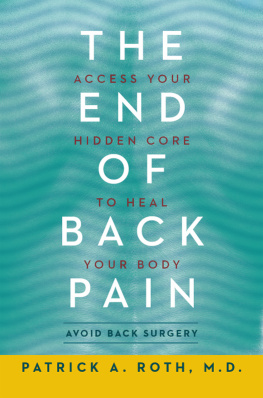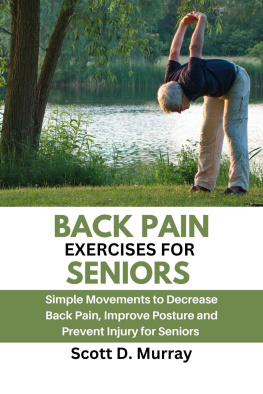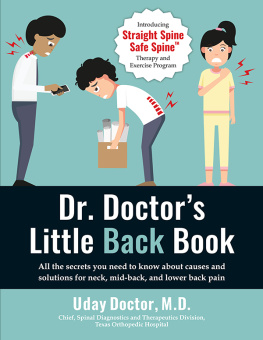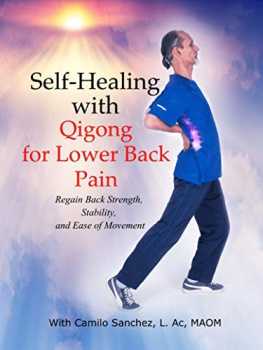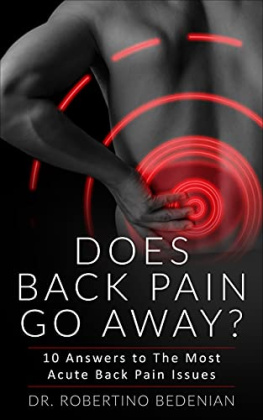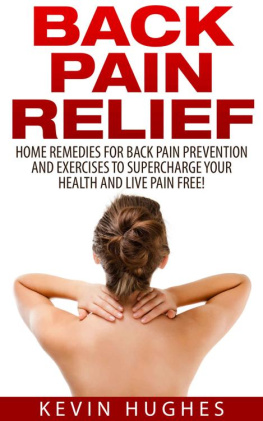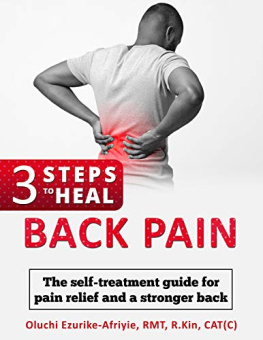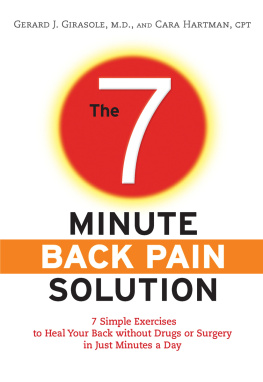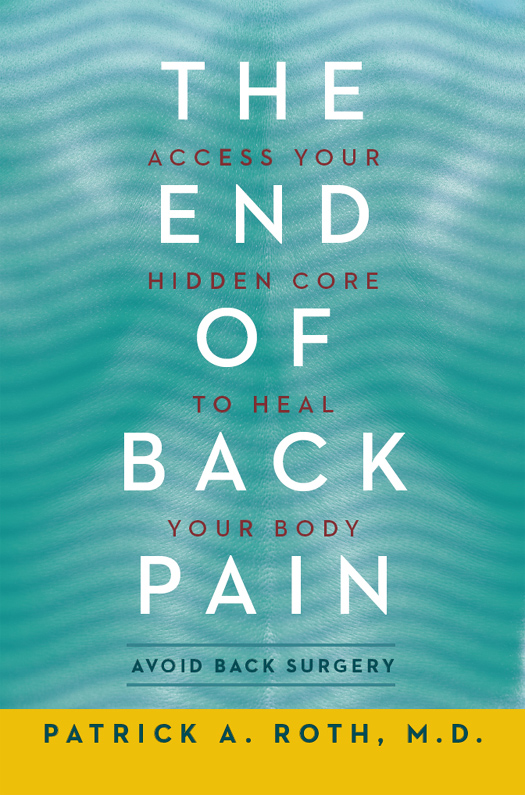To my wife, who taught me how to give
To my children, the greatest of gifts
CONTENTS
I T WAS ONE of those experiences you dont forget. Many years ago, when I was a neurosurgery resident, I was awakened in the middle of the night by a call from a new patient named Tom.
If I had a gun, he said, I would blow my brains out.
My heart pounded as I tried to figure out how to respond. All I could think to do was ask the simplest, most obvious question: Whats wrong? The floodgates opened. Tom told me he was suffering from excruciating pain in his back. He had sought help from various providers over the years, he said, but nothing was working. His pain just kept getting worse, and finally, in his bleakest moments alone, the pain had reached a debilitating level. His back pain was so severe that he was unable to move. He was sure that he needed surgery, and feared lifelong disability.
After listening to Tom, I tried to dispel his darkest fears by explaining to him what was happeningwhy his back likely hurt and what might happen over the coming days. I suspected that most of his pain was the result of muscle spasm. I assured him that as painful as this episode was, it was a common occurrence that would subside within a day or two. I provided Tom with a plan, complete with a timetable of when to expect to feel some relief.
I was curious as to whether the pain he was experiencing had changed now that his fear had decreased and his anxiety was under control. Do you need some medication for the pain tonight? I asked.
Doc, Tom said, I have to tell you the strangest thing. At this moment, I have no pain at all.
Later that night, awake in bed, I was struck by this question: In a matter of minutes, how could Tom go from experiencing pain that made him suicidal to experiencing no pain at all? The encounter planted a seed in my mind that would ultimately grow into a deep interest in back pain. But my interest has other sources as well, some of them more personal.
When I was a teenager, my father bought a Roman chair and put it into the basement to complete his primitive home gym. Sometimes referred to as a hyperextension machine, a Roman chair looks like a cross between a pommel horse and a prayer kneeler. Its designed to work the muscles in your back and abdomen and is usually positioned in a gym near the pull-up bars or any other piece of equipment built to pit you against your own body weight.
I used to use the chair in high school, particularly when my back acted up, which happened more often than I wanted to admit. Because I was active in sports, my back frequently gave me fits. The morning after a game, for instance, I could sometimes barely put on my shoes. I had to learn how to slip them on without bending over or using my hands.
No one recommended the Roman chair for my back pain; I discovered its usefulness quite by chance. With the innocent curiosity of a young person, I experimented with my fathers device, and I was surprised to discover that my back immediately felt better. I didnt understand why it helped, but I remember going down to the basement and using it whenever my back hurt, even during an acute episode of pain. Im certain that if this chair had not been introduced to me early in life, I would have learned either to rest or to resist exercise during an acute episode of pain.

Fast-forward twenty years to my late thirties. (Believe me, it feels like time went that fast!) I was at a party and met a man named Jake. He had heard that I was a neurosurgeon and couldnt wait to tell me how hed overcome his own back pain, which had been crippling. He had tried epidural injections, physical therapy, chiropractic, and acupunctureall without success. In frustration, he had searched the Internet and ultimately connected with the world of kettlebellscast-iron cannonball-shaped weights with handles.

Over a period of months he had strengthened his body by swinging the kettlebells. He started to notice two things: His back felt better, and he felt fitter than ever before. He was in his fifties and had recently entered and won an international strength competition for his age and weight class. (Admittedly, there arent a lot of fifty-year-olds who weigh 140 pounds and want to compete in such an event.)
As he spoke, I was mesmerized. How could a guy in his fifties make such a transition? How did he have the nerve to pursue such a vigorous program with debilitating back pain? But then I remembered my own experience as a teenager and, later, as a newly minted neurosurgeon, when I, too, had discovered that exercising, even while in pain, had met with success.
When I was just starting to practice neurosurgery, I experienced a month-long episode of severe back pain. A magnetic resonance imaging (MRI) test of my lumbar spine revealed a herniated L5S1 disc, as well as a chronic condition called spondylolisthesisthe result of a stress fracture that had occurred while I was playing football years before (and that undoubtedly had been the cause of my adolescent back pain). I showed my MRI to my neurosurgical peers, who uniformly recommended surgery. I was just starting my career, however, and couldnt bear the idea of spending several weeks in recovery.
Although I had always preached the importance of exercise to my patients, I was too frightened to undertake any exertion myself. My pain had improved enough for me to function, but the fear that exercise would bring it back prevented me from following my own advice. Slowly, though, my hypocrisy ate away at me, until I finally got up and, despite the pain, started to exercise. I returned to the Roman chair. I started slowly, with a few reps, then steadily increased the intensity of my workouts. I felt an immediate difference. My back began to feel a comforting sense of tone and strength. As my back pain slowly receded, I became convinced that I was on the right track.
Years later, while I was listening to Jake, all of these thoughts came together. In each case an active approach to exercise had helped alleviate back pain. I didnt quite know it yet, but I had just backed my way into discovering the importance of strengthening the back muscles and the correlation between these muscles and back pain, both as a cause and as a solution. I also realized that this kind of exercise could be initiated earlier than is traditionally accepted in the course of a patients treatment.
My search of the literature revealed similar explorations into exercise strategies, but the strategies described had only sporadic success and thus had never become mainstream. That research convinced me that pain-plagued back muscles could be exercised safely, however, and so I began to treat my more ambitious patients with intense back-strengthening. The patients who committed to the program were rewarded with terrific results.
CORE CONSIDERATIONS
The muscles of the backparticularly the multifidus musclesare an integral part of our core, but they have too often been overlooked. I like to think of these muscles as the bodys hidden core. Our culture has experienced a rich history of strengthening the core to alleviate back pain, a history that peaked in the 1990s when the transversalis muscle (the deep muscle located in the front of your abdomen) was singled out as the essence of the core. This faulty and incomplete definition of core suggested that an isolated group of muscles could be developed and used to stabilize the spine and, in turn, reduce back pain. The discipline of Pilates, for example, promotes the strengthening of the transversalis muscle as a means to stabilize the trunk of the body during movement, which limits stress on the spine.

